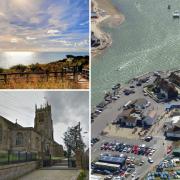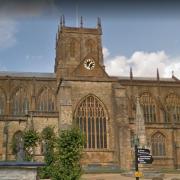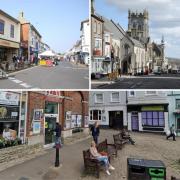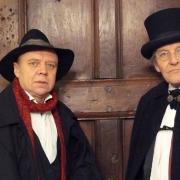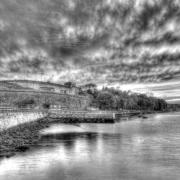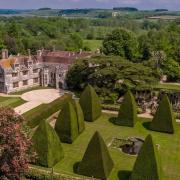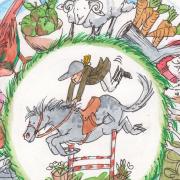From spectral Roman armies and a beneficent black dog to Athelhampton’s duelling ghost and a grieving ape discover some of Dorset’s spookier residents

The ancient county town of Dorsetshire, has many ghosts. Unsurprisingly some of them result from the infamous ‘Bloody Assizes’ of 1685. Judge Jeffries’ lodging house, 6 High West Street, is said to be haunted by the restless souls of the executed victims of his rough justice, whose heads ended up on spikes on the church railings opposite. The judge is said to haunt Antelope Walk, appearing at night from the doorway at the rear of his lodgings, and walking a few yards downhill before disappearing at the entrance to the dining rooms of the Antelope Inn (now The Oak Room).
More ancient in origin are the ghostly Roman soldiers which have been seen at both Maumbury Rings, the henge monument which was converted into an amphitheatre by the Roman army, and Maiden Castle, the huge Iron Age hill fort just outside the town.
In 1969 in Thorncombe Wood, close to Thomas Hardy’s birthplace at Bockhampton, on the line of the old Roman road to Badbury Rings just outside Dorchester, a Roman soldier was seen by a group of borstal boys on a ‘working camp’ from Guys Marsh, at Shaftesbury. According to the officer in charge the soldier, complete with shield, sword, toga and helmet hovered ‘about two feet in the air’ - the estimated level of the original Roman road surface. In 1661, two holy men saw what were afterwards interpreted as a large cohort of Roman Cavalry on the old Roman Road from Eggardon to Dorchester.
The writer Thomas Hardy, said he saw a ghost in Stinsford Churchyard on Christmas Eve, after laying a sprig of holly on his grandfather’s grave. His sister, Kate, interpreted the spectre as their grandfather. The ghost uttered the words ‘A green Christmas’ to Hardy before disappearing into the church. It seems the author may still maintain a presence in his former Dorchester residence Max Gate, as the National Trust’s staff there have occasionally noticed a sudden drop in temperature, accompanied by a strong smell of tobacco smoke.

Athelhampton’s Ghostly Cohort
If Dorchester is the most haunted town in Dorset, then Athelhampton Hall, near Puddletown is the county’s most haunted house. Mentioned in the Domesday Book of 1086, the manor was held by the Bishop of Salisbury. By the 13th century it was the seat of the Pydele family. Around 1350 Sir Richard Martyn married a Pydele heiress, and the Martyns became Lords of the Manor for the next 250 years.
The crest of the Martyn family was a chained ape, looking into a mirror, with the motto ‘He who looks at Martyn’s ape, Martyn’s ape shall look at him’. The crest is depicted in the windows of the great hall, and probably gave rise to the tale that the last of the line, Nicholas Martyn, kept a pet ape. When Nicholas died in 1595, the ape searched in vain for its new master, but found only the four surviving daughters. Its restless spirit is said to haunt a secret passage behind the Great Hall, which led to the underground chamber in which it was kept.
Other sounds emanating from behind the scenes come from the wine cellar where a ghostly cooper may be heard, tapping away at a barrel. A secret door from the Great Hall leads to the cellar, which, according to legend also had a tunnel which led to the woods near the village.

The Great Hall itself is haunted by two ghostly duellists - a phenomenon said to date from the Civil War, when the manor had Royalist associations.
In the East Wing there is a State Bedroom which still has its 15th-century fireplace and a small private chapel reached through a low Gothic arch. This room is frequented by yet another of Athelhampton’s restless spirits - The Grey Lady who passes through the walls either to the landing or the Yellow Bedroom next door. Once when asked to leave by a housemaid as the house was closing for the day, she obediently disappeared through the panelling.
Other resident ghosts listed at athelhampton.com include: The Hooded Priest - a figure in a dark hooded cloak often seen walking down the drive and through the Great Hall; The Soldier - fleeting sightings in the gardens, reports differ on the uniform, but troops were billeted at Athelhampton in the run-up to D-day; “Hello” lady - a new addition, three staff members since July when working on their own have been greeted by this woman’s voice, the theory is that the recent sale of Athelhampton’s furniture may have caused some upset within the spectral domain; The Bride - seen in 2018 in the gardens, the bride was described as dressed in an out-of-fashion dress, there were no weddings happening when she was seen.

Black Dogs
Phantom black dogs abound in British folklore. Frequently associated with places such as lonely crossroads, or prehistoric sites, they are even friendly, helping people (especially vulnerable young women) to find their way when lost. Thomas Hardy was obviously acquainted with such legends when he gave Fanny Robin just such a spectral companion in Far From the Madding Crowd.
Far less benevolent is the terrifying Row Dog, which is said to haunt Cave Hole on the south-eastern coast of Portland. This ‘Devil’s dog’ is described as black and shaggy, as high as a man, with large fiery eyes, one green, one red; entwined in his dark fur can be seen the freshly-plucked eyes of his victims.
The best known of Dorset’s spectral hounds is the Black Dog of Lyme. The story, which dates from the early 19th century, tells how the occupant of a farmhouse that had once been a part of Colway Manor at Uplyme, encountered a large black dog, which would settle itself down beside him near the fire in the evening. The man grew quite fond of this benevolent apparition, but his neighbours advised him to drive the creature away. ‘Why should I?’ he declared. ‘He costs me nothing, he drinks nothing, he eats nothing, he interferes with no-one. He is the quietest and frugalist creature in the house.’
One night, however, having been drinking heavily, and goaded by the taunts of his neighbours who had questioned his courage, he rushed at the dog with a poker. The dog leapt from the floor and disappeared through the ceiling. Frustrated, he struck at the ceiling and, from the spot where the dog had passed through, down fell a box full of gold coins from the time of Charles I’s reign.
The man used this treasure to buy a property a short distance from the house, which he turned into an inn named The Black Dog after his spectral benefactor. Sadly, the old inn was demolished around 1915, when the current building, now a tea room, was built. For years the black dog haunted the lane between the farmhouse and the inn (unofficially known as Dog Lane); it was last seen in 1959.
Read more tales of Dorset myth, legend and folklore in Jerry’s monthly publication merrymeetmagazine.co.uk




